Keywords
|
| information overloading, keyword query, fast retrieval, content recommendation, recommendation systems. |
I. INTRODUCTION
|
| Web is an important medium to satisfy a user who seeks information about any topics. Due to the explosive growth of social network websites and online user generated content systems personalization is a desirable feature for each website. While browsing on a portal website, time is less and amount of data resulting from search engine is more. To optimize content delivered to a user most of the search engines use content recommendation. The software tools and techniques providing suggestions for items to be of use to a user are called content recommendation. Recommender systems are a subclass of information filtering system which predict the users rating or preference on an item. The suggestions given by the recommendation system are based on user’s decision making process etc like what to buy, what to read, what to watch. The term content item is used to denote what the system recommends to a user. |
| In recent years recommendation systems are used everywhere. The main characteristic of a recommendation system is that they draw the interest of user and provide better response to a user. The main application areas are movies, news, books, research articles, search queries and products like dress, fancy, electronic gadgets etc. And also there are recommendation systems for restaurants, life insurance, financial services, jokes, experts, twitter followers etc. |
| In the first section below, we describe the methods most popularly used for building recommendation systems such as collaborative filtering, content based predictor, knowledge based method , demographic filtering and Hybrid content based collaborative filtering method. In second section there is a comparison on different methods. The third section deals with the advantages of content recommendation in portal websites and then the last one is the concluding part of our paper. |
II. RECOMMENDATION TECHNIQUES
|
| Different techniques [8] are used in content recommendations for search engines. [9] Recommender systems typically produce a list of recommendations in one of two ways - through collaborative or content-based filtering.[1] Each method has its own strengths and weaknesses. |
A. Collaborative Filtering
|
| The most popular and widely used method in recommender systems is Collaborative Filtering. This approach builds a model from user’s past behaviour as well as similar decisions made by other users, then use that model to predict items to a user. In fig.1, CF systems collect user feedback as user ratings for content items and exploit similarities and differences among other users. Similarity in taste of two users is calculated based on the similarity in the rating history of users. This is why the technique got the name collaborative filtering which means people-topeople correlation.[3] In domains where there is not much content associated with items or where the content is difficult to analyse ideas, we use CF. This system has the ability to recommend items that are relevant to a user. These two are the advantages of collaborative filtering over other methods. So CF systems are widely used to develop recommender systems. There are four problems associated with recommendation based on CF, they are: [2] |
| • Sparsity: User item-rating matrix is sparse because most of the users do not rate most of items. Thus even most popular item has very few ratings. So it is difficult to find users with similar ratings. This problem occurs when systems have high item-to-user ratio or when the system is in initial stage of use. |
| • First –rater problem: An item cannot be recommended unless a user has rated it before. This problem occurs for new content items. |
| • Cold Start: To make accurate recommendations CF systems need a large amount of existing data on a user. |
| • Scalability: There are millions of users and products. So a large amount of computation power is necessary to calculate recommendations. |
| B. Content Based |
| In this method recommendation is from a set of items with similar characteristics.[3]Content based predictor method is based on description of item and a profile of user’s preference. In fig.2, CB system keywords are used to describe items and user profile is created to indicate the items which that user likes. User profile creation is based on two type of information. One is user’s preference and other is user interaction history. The system first learns items that are similar to the ones user liked in the past. Then create a content based profile of users based on weighted vector of item features. Similarity of items is calculated based on the features associated with the compared items. Weights denote the importance of an item to a user. Like or dislike is a form of direct feedback from a user so it can be used to assign higher or lower weights. Various candidate items are compared and best matching items are recommended. As an example, if a user has rated a video as comedy category then he/she gets further recommendation from that category. CB method can uniquely characterize each user. The main disadvantages of content based predictor are: |
| • Limited capability to recommend content items that are new to the site.[1] |
| • Whether the system is able to learn user preferences from user actions. |
| • When system is limited to recommending content of same type as user already using, the value from recommendation system is less than when other content types from other services can be recommended. |
| C. Knowledge Based Method |
| Knowledge based systems [5] uses the knowledge about users and products. In fig.3, knowledge based method recommends items based on inferences about a user’s needs and preferences. In this method first find knowledge about how certain item features meet users’ needs and preferences and, how the item is useful for the user. Then estimate a similarity function for how much the user needs match the recommendations. Similarity score can be directly interpreted as the source of recommendation for the user. [7]Advantages of knowledge based methods are, it doesn't have the “ramp-up” problem since its recommendations don’t depend on any database of user ratings. Users are interested in understanding the information space and they make details more on their needs. The judgements of this method are independent of individual tastes so there is no need to collect information about a particular user. There are some disadvantages to this method. To make useful recommendations the system need a knowledge database. This knowledge base need frequent updating to keep up with the ever-changing consumer ratings and preferences. This system only gives static suggestions so user gets what is contained in the database. |
| D. Demographic Filtering |
| This system recommends items based on the demographic profile of the user. [3]This method use different demographic attributes, such as age, gender, and occupation, for recommendation purpose. Different recommendations are generated for different demographic locations by combining the ratings of users in those locations. Recommendation based on demographics is simple and effective. As an example, users are send to a particular Web sites based on their language or country. In demographic recommendation, fig.4 suggestions may be based on the age of the user. This method is mainly used in marketing field. Demographic attributes avoid cold start problem. [4] |
| E. Hybrid Recommender System |
| All the methods we described have their own strengths and weakness. So we adopt a hybrid recommender system by combining two or more recommendation techniques to get better content optimization. The most popular hybrid method combines Content based predictor and Collaborative filtering recommender systems. [10]By combining content and collaboration an elegant and effective framework can be developed. Hence the name Content Based Collaborative Filter(CBCF).[2] This can be implemented in different ways: By making content based and collaborative predictions separately and then combining them; by adding content based predictions to a collaborative filter; by unifying both methods into a single one. In fig.5, a Content based Collaborative filter performs better than a pure content based predictor or pure collaborative filter.[1] In CBCF, content based predictor is used to enhance existing user data and then provides personalized suggestions through collaborative filtering. This method is effective and provides more accurate recommendation to a user. CBCF [6] also overcome problems like cold start and sparsity problem. It also overcome first rater problem. CBCF can improved by improving content based predictor or collaborative filtering methods. |
ADVANTAGES OF RECOMMENDER SYSTEM
|
| • It increases user satisfaction. |
| • Increase number of items sold. |
| • Sell more diverse contents. |
| • Increase user fidelity. |
| • Better understanding what the user wants. |
CONCLUSION
|
| This paper analyses various techniques used for content recommendation and there comparison. Content recommendation is an important process in websites. So the method should be selected properly. The first method collaborative filtering builds a model from user’s past behaviour as well as similar decisions made by other users, and then uses that model to predict items to a user. Content based predictor method is based on description of item and a profile of user’s preference. Knowledge based systems uses the knowledge about users and products. Demographic filtering system recommends items based on the demographic profile of the user. Hybrid method combines content based predictor and collaborative filtering method. Among these methods the most widely used method is hybrid method. It overcomes the shortcomings of single recommender methods. |
Tables at a glance
|
 |
| Table 1 |
|
| |
Figures at a glance
|
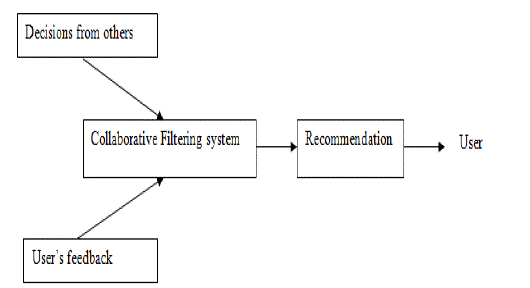 |
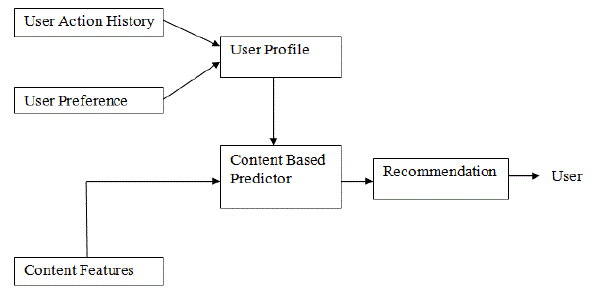 |
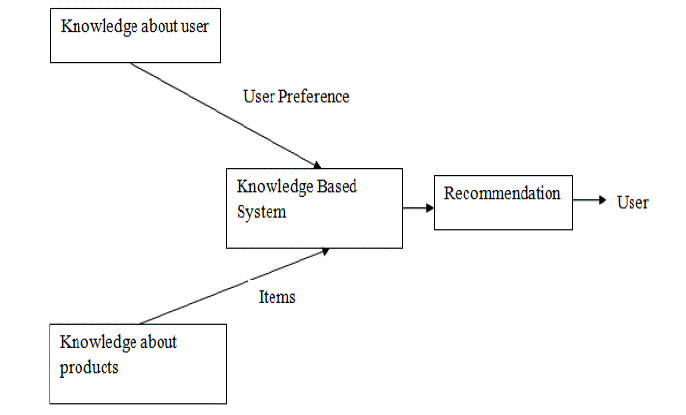 |
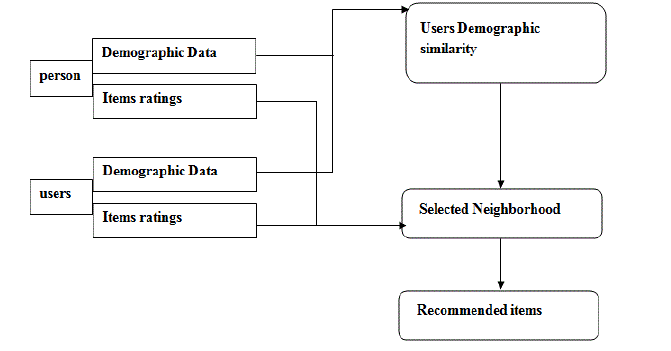 |
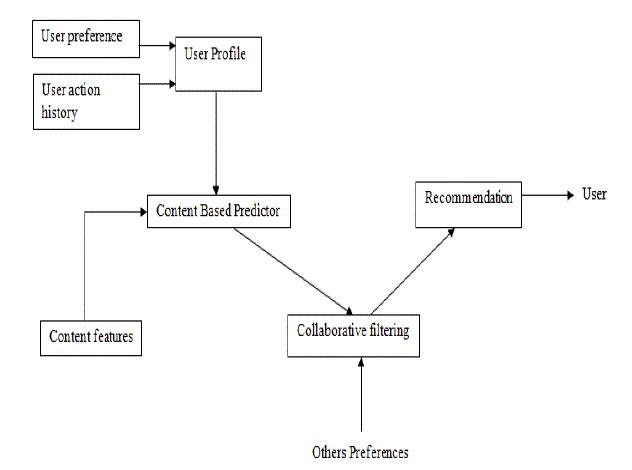 |
| Figure 1 |
Figure 2 |
Figure 3 |
Figure 4 |
Figure 5 |
|
| |
References
|
- Jiang Bian, Anlei Dong, Xiaofeng He, Srihari Reddy, and Yi Chang,” User Action Interpretation for Online Content Optimization” IEEETransactions on Knowledge and Data Engineering, vol. 25, no. 9, 2013
- Prem Melville and Raymond J. Mooney and RamadassNagarajan, “Content-Boosted Collaborative Filtering for Improved Recommendations,”Proc. 18th National Conf. on Artificial Intelligence), pp. 187-192, Edmonton, Canada, July 2002.
- Francesco Ricci and LiorRokach and BrachaShapira, “Introduction to Recommender Systems”, Recommender Systems Handbook, Springer,2011, pp. 1-35.
- LailaSafoury and Akram Salah,” Exploiting User Demographic Attributes for Solving Cold-Start Problem in Recommender System” LectureNotes on Software Engineering, Vol. 1, No. 3, August 2013.
- Robin Burke, “Knowledge-based recommender systems” Department of Information and Computer Science, University of California, Irvine.
- Basu, Haym Hirsh, William Cohen, “Recommendation as Classification:using Social and Content Based Information in Recommendation”AAAI-98 Proceedings, 1998
- Wikipedia/ Knowledge Based and Demographic Feature Based content recommendation.
- Wikipedia/Content recommendation Methods and its Classification.
- PrzemyslawKazienko and PawelKolodziejski,” Personalized Integration of Recommendation Methods for E-commerce”, International Journalof Computer Science & Applications ã 2006 Techno mathematics Research Foundation Vol. 3 Issue 3, pp 12-26
- Robin Burke,” Hybrid Web Recommender Systems”, School of Computer Science, Telecommunications and Information Systems
- DePaul University, 243 S. Wabash Ave.Chicago, Illinois, USA
|
BIOGRAPHY
|
| Neethu Raj is a Master of technology (M-tech) student in Computer Science Department, College of Engineering, Perumon. She received her Bachelor of Technology (B-tech) degree from Cochin University of Science and Technology. Her research interests are Data Mining, Image processing, Network security etc. |
| Suja Rani M S, is an Assistant professor in Information Technology Department, College of Engineering, Perumon. She received her Master of technology (M-tech) degree from MS University and Bachelor of Technology (B-tech) degree from Kerala University. Her research interests are Computer Networking and Data Mining etc. |